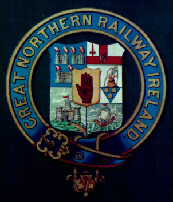 GNRI Coat
of Arms. Source: SRA696
GNRI Coat
of Arms. Source: SRA696
 GNRI Coat
of Arms. Source: SRA696
GNRI Coat
of Arms. Source: SRA696
Formed from an amalgamation of the Ulster [1839], Northern
Railway [1875] (Dublin and Drogheda Railway [1844] and
Dublin and Belfast Junction Railway [1848]) and the Irish
North Western Railways [1862] (formerly Dundalk and
Enniskillen Railway [1845] which rented the Londonderry and
Enniskillen Railway [1847], which in turn had an
independent existence until bought out in 1883) in 1876.
Subsequent mergers, in 1879 with Newry and Armagh Railway
[1857](previously Newry and Enniskillen Railway [1854]), in
1885 with Belfast Central Railway [1875], in 1886 with the
Newry, Warrenpoint and Rostrevor Railway and in 1913 with
the Castleblayney, Keady and Armagh Railway. Became the
Great Northern Railway Board [1953], which began operations
on 1/9/1953. On 1/10/1958 CIE and the UTA took over its
operations in the 26 and 6 counties respectively. Rolling
stock was apportioned between the two companies.
Rolling stock: Between 39 and 47 (sources differ)
locomotives were constructed at the Dundalk works
[1881-1958] while 230 were purchased elsewhere, Beyer
Peacock being the favoured supplier (+/- 150). 12 carriages
from Metropolitan in 1877
Works: Dundalk.
Livery: 1904 (RM 10/1904, p.282) Loco and tender -
green, crimson frame, black and white lining; coaches teak
varnish. After 1926 (Baker) Locos: 1916-28 black with red
lining. Great Northern on tender and tank sides. Crest on
splashers of tender engines. 1928 onwards black with no
lining, initials GNR on tender and tank sides, no crest.
Compounds from 1933 in black with double red lining. Great
Northern with crest between on tender sides. In 1935
repainted in sky blue with blue and black lining, initials
GN on tender with crest between and crest also above
spashers. Similar livery borne by rebuilt S and S2s from
1938 also new VSs and Vs on delivery and eventually, after
1948, all 4-4-0s except smallest. Carriages varnished
mahogany, until 1928 lined straw. Numbered and lettered in
gold shaded blue. Crest on sides. Metal panelled stock
orange-brown after brief period of imitation wood graining.
Railcars blue lower and cream upper bands. Wagons grey.
[WR: From 1934, the GNR began to make more lavish use of of
coa on both engines and carriages, using a large version,
much bigger than the small one which had been used at one
time but discontinued for some years. Compounds were
originally painted black with red lines. They were
repainted blue in 1936 and this was extended to the 170
class in 1938].
Staff: Locomotive superintendents were W.Curry
1875 (northern Railway), J.Eaton, T.Callaghan, W.Curry, and
C.Clifford 1876, J.C.Park and J.Eaton 1880, J.C.Park 1885,
C.Clifford 1895, G.T.Glover 1912, G.B.Howden 1933, and
H.R.McIntosh 1939, R.W.Meredith 1950, H.E.Wilson 1957-8.
Secretaries were J.P.Culverwell 1876, H.Plews 1890,
T.Morrison 1896, J.B.Stephens 1919, F.C.Wallace 1926 and
[GNRB] P.K.M.Carey 1952. General Managers were T.Robertson
1890, H.Plews 1896, J.Bagwell 1911, J.B.Stephens 1926,
G.B.Howden 1939-52. For officers of constituents see
Appendix 2 The Great Northern Railway of Ireland
E.M.Patterson.
Signalling: Watches provided to staff on Howth
branch on 30/7/1846. Absolute block between Amiens St. and
Raheny in 1877.On double line absolute block system -
Harper's instruments. Exceptions were third line
Belfast-Balmoral and Belfast Central - permissive block
working (absolute block later for passenger workings).
Single lines by electric train staff and in its later years
Goraghwood-Markethill - single line staff. Howth tramway -
bull's eye electric lights.
Other: Eight types of uniform in 1877:
Stationmaster Grade 1, Grade 2, Guard, Ticket Collector,
Goods' guard, Head porter, Porter, Pointsman.
Extensive publicity campaign in spring 1935 with posters
and booklets. Best known poster was 1938 Boyne viaduct.
Further reading: K.A.Murray The
GNR(I), E.M.Patterson The GNR of Ireland,
R.M.Arnold The Golden Years of the GN railway, Volumes
I and II, J.McQuillan The Railway Town,
Michael C. Baker Irish Railways since 1916, W.Robb
"Recollections of the GNR", JIRRS 672.
Norman Johnston's authoritative Locomotives of the
GNRI, published by Colourpoint, helped to
clear up a perplexing problem for me. Of particular
interest was Ch 12 of the book which covers GNR(I) tenders.
Now, thanks to Norman's research, I know from which
types my plates (one of which is illustrated on next page)
come. Norman Johnston The
Great Northern Railway (Ireland) in colour.
![]() Web: Try a picture of Railway
Signal Company Great Northern
Railway of Ireland pattern frame. Also GNR
buses has a useful treatment of that aspect of GNR
operations.
Web: Try a picture of Railway
Signal Company Great Northern
Railway of Ireland pattern frame. Also GNR
buses has a useful treatment of that aspect of GNR
operations.
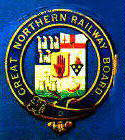 GNRB Coat
of Arms Source: SRA696
GNRB Coat
of Arms Source: SRA696
Comment: Two main varieties exist, the GNRI (shown
at top of page) and the GNRB (shown above). Within these
varieties there are differences in size and in the colour
of the garter. As far as size is concerned, there seem
basically to be a large (variously described in auction
catalogues [no. of occurrences recorded] as loco [1GNRB,
1GNRI turquoise], tender [2GNRI], large [1GNRI,1GNRB] ) and
small (described as such at auctions 5 [4GNRI, 1GNRB]
times). Remaining appearances are either, not stated
[11GNRI], or GNRI blue garter 30 cms [SRA 692]. The latter,
if the diameter of the transfer rather than the board,
would suggest that, in addition to the large [45.5] and the
small [20.5], there is one somewhere in between. On the
colour of the garter, there are dark blue and turquoise
varieties, seemingly, of each. I have a dark blue 45cm GNRI
(the mate of the turquoise loco?), a dark blue 20cm GNRB,
and a turquoise 20cm GNRI. A tentative classification might
be:
I20T: Small GNRI turquoise - quite common;
I20B: Small GNRI dark blue - to be proved;
B20T: Small GNRB turquoise - quite common;
B20B: Small GNRB dark blue - to be proved;
I30B: Medium GNRI dark blue - to be checked;
I45T: Large GNRI turquoise - exists;
I45B: Large GNRI dark blue - exists;
B45T: Large GNRB turquoise - to be proved;
B45B: Large GNRB dark blue - to be proved.
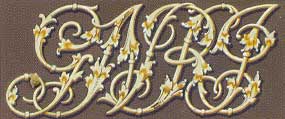 GNRI monogram. Source:
© G. Hartley (scan RCJ)
GNRI monogram. Source:
© G. Hartley (scan RCJ)
Locomotive nameplates: ERNE, FALCON, LUGNAQUILLA,
DOWN, LOUTH, EAGLE, SLIEVENAMON, PEREGRINE - UFTM+IRRS,
GALTEEMORE - UFTM, CARRANTUOHILL - IRRS, FOYLE - IRRS,
KESTREL - IRRS, LOUGH DERG - IRRS, MEATH - IRRS, ERNE -
FRY.
 GNR nameplate.
Source: SRA601
GNR nameplate.
Source: SRA601
See supplementary GNRI rolling stock railwayana page for additional name and number plates
Works & tenderplates:
 GNR makers
plate
GNR makers
plate
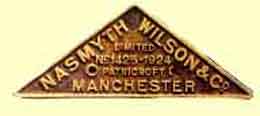 Makers'
plate No. 115 Source: SRA900
Makers'
plate No. 115 Source: SRA900See supplementary GNRI rolling stock railwayana page for additional makers' plates
Carriage and wagon plates:
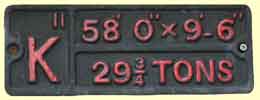 GNR K11
carriage plate
GNR K11
carriage plate
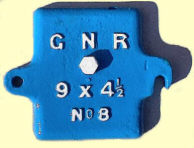 GNR axlebox
cover. Source: D.Cronin
GNR axlebox
cover. Source: D.Cronin
See supplementary GNRI rolling stock railwayana page for additional items
Footbridge: SRA1296
Bridge Restriction: Full title enamel.
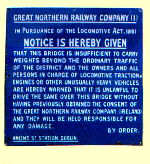 GNR enamel
bridge. Source: SRA698
GNR enamel
bridge. Source: SRA698
See supplementary GNRI lineside railwayana page for additional signs
Bridge Numbers:
So far 14 at auction. Those actually identified in
catalogues, and others known to exist, are as
follows:
No.8, No.14, No.17, No.27, No.38, No.59, No.66, No.69,
No.86, No.87, No.151, No.153, No.200, No.274.
 One GNRI
bridge. Click for the other
five.
One GNRI
bridge. Click for the other
five.
Cast Iron Trespass:
 Post
mounted. Source: SRA600
Post
mounted. Source: SRA600
TR1 Early post-mounted trespass - one auctioned (originally thought GNR)
See supplementary GNRI lineside
railwayana page for additional trespass signs
including:
CT1 [23x30cm] (substitute railway/tramway in photo) -
several exist, IRRS one;
CT2 [23x30cm] (tramway, photo) - IRRS one: 'tram'
looks specially modified;
CT3 [28.4x56.4cm] (photo) - several exist;
CT3b similar Board version - at least one exists
CT4 [13.8x20.2cm] (small variety, photo) - quite a
number;
SRA988, ORA390, SRA990, SRA491, SRA691, Full title enamel
SRA1091, 28x56cm ORA392, small SRA692 (20x13cm),
Enamel(battered!) ORA792, small SRA293, BRA693 (20x13cm),
BRA294, 28x57cm 5 line welded BRA497.
Enamel Trespass:
GNR enamel ET1 (photo on supplementary
GNRI lineside railwayana page)
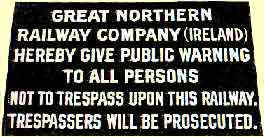 GNR
enamel ET2. Source: BRA
GNR
enamel ET2. Source: BRA
GNR enamel ET3 (photo on supplementary GNRI lineside railwayana page)
ET1 (photo) - at least one exists;
ET2 [30.4x50.8] (photo) - at least two exist;
ET3 Simpler than ET1 or ET2, with few words, appeared at
Kiddlington auction 7/92.
Enamel Billposters:
 GNR enamel
EB1 EB1 [40.8x45.8cm] (see photo) - several exist.
GNR enamel
EB1 EB1 [40.8x45.8cm] (see photo) - several exist.

GNR title arc (straight on supplementary GNRI lineside railwayana
page ), cast iron
 Sutton
(Donabate, Strabane and St. Johnston on supplementary GNRI lineside railwayana
page )
Sutton
(Donabate, Strabane and St. Johnston on supplementary GNRI lineside railwayana
page )
 GNR station
enamel, blue/white
GNR station
enamel, blue/white
Station (seats from recollection):
'Donabate' 40x12cm rounded ends, 'Sutton',
'Strabane', 'St. Johnston' 54x11.4cm.
 GNR?(BNCR)
door sign (See supplementary GNRI
lineside railwayana page for additional signs)
GNR?(BNCR)
door sign (See supplementary GNRI
lineside railwayana page for additional signs)
Ladies waiting room - Fry, Others - private
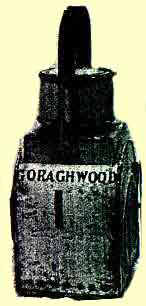 GNRI headlamp. Source:
BRA401. (See supplementary GNRI
lineside railwayana page for a second lamp, clock and
bell)
GNRI headlamp. Source:
BRA401. (See supplementary GNRI
lineside railwayana page for a second lamp, clock and
bell)
Mileposts: '3/4', Set 20, 1/4, 1/2, 3/4
mounted.
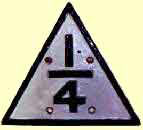 GNR
mileposts (See supplementary
GNRI lineside railwayana page for 1/2 and
3/4)
GNR
mileposts (See supplementary
GNRI lineside railwayana page for 1/2 and
3/4)
![]() GNR gradient
signs (See supplementary GNRI
lineside railwayana page for ramps up)
GNR gradient
signs (See supplementary GNRI
lineside railwayana page for ramps up)
Railchair: BRA794
Signalling: Miniature SL 'Newtown Butler-Clones West', 2 ground signals, 4 aspect - copper, WT staff 'Castle Caldwell-Belleek', Miniature 'Nenagh-Birdhill', WT staffs 'Laytown-Mosney', 'Dundalk South-Dundalk Barrack St.' Handlamp
Cutlery, china, ashtrays etc.: Astrays, chrome from railcar, silver milk jug, china milk jug, ewer, 3 plates, soup dish, peanut dish, inkwell.
Miscellaneous: Strabane clock, hinge, Coach board Bundoran
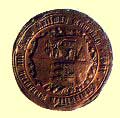 Enniskillen,
Bundoran & Sligo copper seal. Source: SRA595
Enniskillen,
Bundoran & Sligo copper seal. Source: SRA595
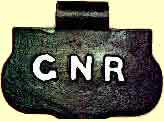 GNR hinge
(probably axlebox - DC) (See supplementary GNRI lineside railwayana
page for spanner and ewer)
GNR hinge
(probably axlebox - DC) (See supplementary GNRI lineside railwayana
page for spanner and ewer)
![]() Return to index page,
or go to GNRI subpage, GNRI rolling
stock railwayana.
Return to index page,
or go to GNRI subpage, GNRI rolling
stock railwayana. ![]()
 Return to auction
price data on original pages
Return to auction
price data on original pages 
![]() For genealogy, go to my Lennan
genealogy pages
For genealogy, go to my Lennan
genealogy pages ![]()
Page content posted 27/7/1997. Revised
11/12/08